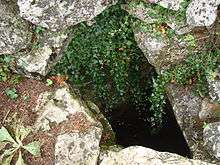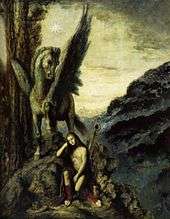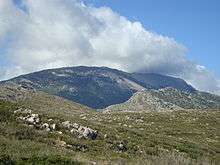Pegasides

Pegasides (Greek: Πηγασίδες) were nymphs of Greek mythology connected with wells and springs,[1] specifically those that the mythical horse Pegasus created by striking the ground with his hooves.[2]
The background
According to Greek mythological tradition the winged horse Pegasus was the son of Poseidon, sea and river god of the Greeks,[3] equivalent to the Roman Neptune.[4] The hero Bellerophon needed the untamed Pegasus to help him defeat the monster Chimera. Hence, while Pegasus was drinking at the spring Pirene in Corinth, Bellerophon caught him. Pegasus, startled, struck a rock with his hoof, creating the spring Hippocrene on Mount Helicon.[5]

The Pegasides
The name Pegasides (plural form of the Greek feminine adjective Pegasis) literally means "originating from or linked with Pegasus".[6] Hence, in poetry, the waters of Hippocrene and other springs that arose from the hoofprints of Pegasus are called Pegasides.[7][3] The Muses are likewise called Pegasides[8] because the spring Hippocrene was sacred to them.[6][3] Nymphs in general, if associated with springs and brooks, may be called Pegasides:[9] thus Pegasis, the singular form, is applied by the Roman poet Ovid as a by-name or adjective to the nymph Oenone, daughter of the river-god Cebrenus.[10][2]
Pegasis is used by the Greek author Quintus Smyrnaeus as the name of a nymph who had sex with the Trojan prince Emathion and gave birth beside the river Granicus to Atymnius. The latter was eventually killed by Odysseus in the Trojan War.[11][12]
Notes
- ↑ Gardner, James (1858-60); p 639.
- 1 2 Lemprière, John; Anthon, C. (1825); p 530.
- 1 2 3 Walford, Edward (1897); p 77, vol 33.
- ↑ Anthon, Charles (1857); p 989.
- ↑ Adam, Alexander (1816); p 394.
- 1 2 Smith, William (1849); p 165.
- ↑ Ovid, Tristia 3.7.15: "the stream of Pegasus" in the English translation; Martial, Epigrams 9.58.6
- ↑ Ovid, Heroides 15.27: "the daughters of Pegasus" in the English translation; Propertius, Poems 3.1.19: "Pegasid Muses" in the English translation
- ↑ Smith, William (1858); p 534.
- ↑ Ovid, Heroides 5.3: "the fountain-nymph Oenone" in the English translation; Pegasis Oenone in the Latin text
- ↑ Quintus Smyrnaeus, The Fall of Troy 3.300–302
- ↑ Parada, Carlos (1997) s.v. "Nymphs: Pegasis"
References
| Greek deities series |
|---|
| Aquatic deities |
| Nymphs |
- Adam, Alexander (1816). A Summary of Geography and History, both Ancient and Modern: with an Abridgment of the Fabulous History of Mythology of the Greeks. London, printed for T. Cadell And W. Davies. OCLC 751291898.
- Anthon, Charles (1857). A classical dictionary: containing an account of the principal proper names mentioned in ancient authors and intended to elucidate all the important points connected with geography, history, biography, mythology, and fine arts of the Greeks and Romans. New York, Harper & Bros. OCLC 1395800.
- Erasmus, Desiderius (1993). Poems: Volume 85-86 (Collected Works of Erasmus). University of Toronto Press, Scholarly Publishing Division. p. 438. ISBN 0-8020-2867-5.
- Gardner, James (1858–60). The faiths of the world; an account of all religions and religious sects, their doctrines, rites, ceremonies, and customs. Edinburgh, London, A. Fullarton & Co. OCLC 4914490.
- Lemprière, John; Anthon, Charles (1825). A classical dictionary; containing a copious account of all the proper names mentioned in ancient authors ... New York, E. Duyckinck, G. Long. OCLC 5897265.
- Parada, Carlos (1997). Genealogical Guide to Greek Mythology. Studies in Mediterranean Archaeology. 107. Coronet Books. ISBN 978-9170810626.
- Smith, William (1858). A classical dictionary of biography, mythology, and geography : based on the larger dictionaries. London : John Murray. OCLC 316433650.
- Walford, Edward; Cox, John C; Apperson, George L. (1897). The Antiquary (1897). Cambridge (eng.): ProQuest LLC, 2008. OCLC 663459113.
